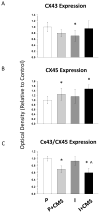Altered Connexin 43 and Connexin 45 protein expression in the heart as a function of social and environmental stress in the prairie vole
- PMID: 25338193
- PMCID: PMC4675659
- DOI: 10.3109/10253890.2014.979785
Altered Connexin 43 and Connexin 45 protein expression in the heart as a function of social and environmental stress in the prairie vole
Abstract
Exposure to social and environmental stressors may influence behavior as well as autonomic and cardiovascular regulation, potentially leading to depressive disorders and cardiac dysfunction including elevated sympathetic drive, reduced parasympathetic function, and ventricular arrhythmias. The cellular mechanisms that underlie these interactions are not well understood. One mechanism may involve alterations in the expression of Connexin43 (Cx43) and Connexin45 (Cx45), gap junction proteins in the heart that play an important role in ensuring efficient cell-to-cell coupling and the maintenance of cardiac rhythmicity. The present study investigated the hypothesis that long-term social isolation, combined with mild environmental stressors, would produce both depressive behaviors and altered Cx43 and Cx45 expression in the left ventricle of prairie voles - a socially monogamous rodent model. Adult, female prairie voles were exposed to either social isolation (n = 22) or control (paired, n = 23) conditions (4 weeks), alone or in combination with chronic mild stress (CMS) (1 week). Social isolation, versus paired control conditions, produced significantly (p < 0.05) increased depressive behaviors in a 5-min forced swim test, and CMS exacerbated (p < 0.05) these behaviors. Social isolation (alone) reduced (p < 0.05) total Cx43 expression in the left ventricle; whereas CMS (but not isolation) increased (p < 0.05) total Cx45 expression and reduced (p < 0.05) the Cx43/Cx45 ratio, measured via Western blot analysis. The present findings provide insight into potential cellular mechanisms underlying altered cardiac rhythmicity associated with social and environmental stress in the prairie vole.
Keywords: Cardiac arrhythmic susceptibility; chronic mild stress; connexins; depression; microtus; social isolation.
Conflict of interest statement
The authors declare no financial or personal relationships with individuals or organizations that would influence the subject matter or materials discussed in this manuscript. The sources of funding for this work include the following: National Institutes of Health grants HL112350 (AJG), HL108475 (M-ALS), and MH77581 (AJG); Northern Illinois University (AJG); and the Iowa Osteopathic Educational Research Fund (JAM).
Figures




Similar articles
-
The integration of depressive behaviors and cardiac dysfunction during an operational measure of depression: investigating the role of negative social experiences in an animal model.Psychosom Med. 2012 Jul-Aug;74(6):612-9. doi: 10.1097/PSY.0b013e31825ca8e5. Epub 2012 Jun 28. Psychosom Med. 2012. PMID: 22753634 Free PMC article.
-
Disruption of social bonds induces behavioral and physiological dysregulation in male and female prairie voles.Auton Neurosci. 2014 Feb;180:9-16. doi: 10.1016/j.autneu.2013.10.001. Epub 2013 Oct 11. Auton Neurosci. 2014. PMID: 24161576 Free PMC article.
-
The effects of environmental enrichment on depressive and anxiety-relevant behaviors in socially isolated prairie voles.Psychosom Med. 2014 May;76(4):277-84. doi: 10.1097/PSY.0000000000000052. Psychosom Med. 2014. PMID: 24804886 Free PMC article.
-
Alterations in cardiac connexin expression in cardiomyopathies.Adv Cardiol. 2006;42:228-242. doi: 10.1159/000092572. Adv Cardiol. 2006. PMID: 16646594 Review.
-
[Remodeling of cardiac gap junctions and arrhythmias].Sheng Li Xue Bao. 2011 Dec 25;63(6):586-92. Sheng Li Xue Bao. 2011. PMID: 22193455 Review. Chinese.
Cited by
-
Social isolation alters behavior, the gut-immune-brain axis, and neurochemical circuits in male and female prairie voles.Neurobiol Stress. 2020 Nov 24;13:100278. doi: 10.1016/j.ynstr.2020.100278. eCollection 2020 Nov. Neurobiol Stress. 2020. PMID: 33344730 Free PMC article.
-
Astroglial Connexin 43-Mediated Gap Junctions and Hemichannels: Potential Antidepressant Mechanisms and the Link to Neuroinflammation.Cell Mol Neurobiol. 2023 Nov;43(8):4023-4040. doi: 10.1007/s10571-023-01426-5. Epub 2023 Oct 24. Cell Mol Neurobiol. 2023. PMID: 37875763 Free PMC article. Review.
-
Connexins and angiogenesis: Functional aspects, pathogenesis, and emerging therapies (Review).Int J Mol Med. 2022 Aug;50(2):110. doi: 10.3892/ijmm.2022.5166. Epub 2022 Jun 28. Int J Mol Med. 2022. PMID: 35762312 Free PMC article. Review.
-
Oxytocin and Social Relationships: From Attachment to Bond Disruption.Curr Top Behav Neurosci. 2018;35:97-117. doi: 10.1007/7854_2017_10. Curr Top Behav Neurosci. 2018. PMID: 28812266 Free PMC article. Review.
-
Opinion: "Heart Rate Variability, Health and Well-Being: A Systems Perspective" Research Topic.Front Public Health. 2017 Sep 25;5:246. doi: 10.3389/fpubh.2017.00246. eCollection 2017. Front Public Health. 2017. PMID: 28993803 Free PMC article. No abstract available.
References
-
- Ai X, Pogwizd SM. Connexin 43 downregulation and dephosphorylation in nonischemic heart failure is associated with enhanced colocalized protein phosphatase type 2A. Circ Res. 2005;96:54–63. - PubMed
-
- Akar FG, Nass RD, Hahn S, Cingolani E, Shah M, Hesketh GG, DiSilvestre D, Tunin RS, Kass DA, Tomaselli GF. Dynamic changes in conduction velocity and gap junction properties during development of pacing-induced heart failure. Am J Physiol Heart Circ Physiol. 2007;293:H1223–H1230. - PubMed
-
- Ando M, Katare RG, Kakinuma Y, Zhang D, Yamasaki F, Muramoto K, Sato T. Efferent vagal nerve stimulation protects heart against ischemia-induced arrhythmias by preserving connexin43 protein. Circulation. 2005;112:164–170. - PubMed
-
- Beardslee MA, Laing JG, Beyer EC, Saffitz JE. Rapid turnover of connexin43 in the adult rat heart. Circ Res. 1998;83:629–635. - PubMed
Publication types
MeSH terms
Substances
Grants and funding
LinkOut - more resources
Full Text Sources
Other Literature Sources
Medical
Miscellaneous
